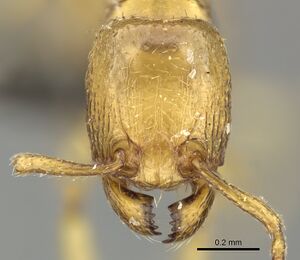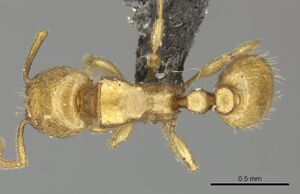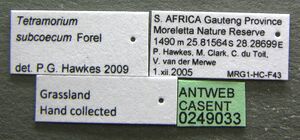Tetramorium subcoecum
| Tetramorium subcoecum | |
|---|---|

| |
| Scientific classification | |
| Kingdom: | Animalia |
| Phylum: | Arthropoda |
| Class: | Insecta |
| Order: | Hymenoptera |
| Family: | Formicidae |
| Subfamily: | Myrmicinae |
| Tribe: | Crematogastrini |
| Genus: | Tetramorium |
| Species: | T. subcoecum |
| Binomial name | |
| Tetramorium subcoecum Forel, 1907 | |
| Synonyms | |
| |
Known from a modest number of collections. Specimen records show T. subcoecum was collected in grassland, acacia woodland, a grassy and rocky slope, and a savanna. It appears to be a ground dwelling species. Specimens were taken from under a dead wood on the ground, a pitfall trap, by hand, in soil, and a Malaise trap (caste not specified).
Identification
Bolton (1980) - In the subcoecum-complex of this group two species are minute and quickly separated from the remainder in size alone. These are Tetramorium typhlops and Tetramorium warreni and they have HW < 0.50, SL < 0.35. The remaining three species, T. subcoecum, Tetramorium amaurum and Tetramorium traegaordhi are larger, and of these T. amaurum is separated by a combination of characters including eyes with 3-5 facets, feeble but visible frontal carinae, rounded metapleural lobes, short pilosity and moderately developed mandibular sculpture. The two remaining species, T. subcoecum and T. traegaordhi, can be separated by the presence in the latter of coarsely sculptured mandibles, eyes with two ommatidia, strongly transverse petiole node which is much broader than long, and long hairs on the alitrunk and gaster. Coupled with this T. traegaordhi lacks the distinct clypeal impression seen in both T. subcoecum and T. amaurum.
Keys including this Species
Distribution
Latitudinal Distribution Pattern
Latitudinal Range: -3.91667° to -25.81564°.
| North Temperate |
North Subtropical |
Tropical | South Subtropical |
South Temperate |
- Source: AntMaps
Distribution based on Regional Taxon Lists
Afrotropical Region: Botswana, Eritrea, Ethiopia, Kenya (type locality), Namibia, South Africa, United Republic of Tanzania, Zimbabwe.
Distribution based on AntMaps
Distribution based on AntWeb specimens
Check data from AntWeb
Countries Occupied
| Number of countries occupied by this species based on AntWiki Regional Taxon Lists. In general, fewer countries occupied indicates a narrower range, while more countries indicates a more widespread species. |

|
Estimated Abundance
| Relative abundance based on number of AntMaps records per species (this species within the purple bar). Fewer records (to the left) indicates a less abundant/encountered species while more records (to the right) indicates more abundant/encountered species. |

|
Biology
Castes
Worker
Images from AntWeb
   
| |
| Worker. Specimen code casent0249033. Photographer Ryan Perry, uploaded by California Academy of Sciences. | Owned by AFRC, Pretoria, South Africa. |
Nomenclature
The following information is derived from Barry Bolton's Online Catalogue of the Ants of the World.
- subcoecum. Tetramorium subcoecum Forel, 1907c: 137 (w.) KENYA. Senior synonym of inscia: Bolton, 1980: 291.
- inscia. Tetramorium subcoecum var. inscia Forel, 1913j: 218 (w.) ZIMBABWE. Junior synonym of subcoecum: Bolton, 1980: 291.
Unless otherwise noted the text for the remainder of this section is reported from the publication that includes the original description.
Description
Worker
Bolton (1980) - TL 2.4-3.0, HL 0.58-0.74, HW 0.52-0.66, CI 85-90, SL 0.40-0.52, SI 75-80, PW 0.34-0.44, AL 0.58-0.80 (10 measured). Mandibles very feebly sculptured, at most with very faint fine longitudinal striae, often more or less smooth with scattered pits or roughened patches with one or two striae. Anterior clypeal margin with a distinct median impression, the portion of the clypeus immediately behind the impression very shallowly transversely concave. Frontal carinae vestigial or absent, at most an extremely feeble raised line which ends before the level of the eyes; generally weaker than this. Antennal scrobes absent. Eyes minute, of a single ommatidium, the maximum diameter 0.02-0.03, about 0.04-0.06 x HW. Propodeum in profile armed witha pair of short triangular teeth which are as long as or slightly longer than the metapleural lobes, the latter broadly triangular. Petiole in profile with both antero- and posterodorsal angles bluntly rounded. In dorsal view the petiole node slightly broader than long to about as broad as long, the dorsal surface rounding into the front, back and sides, no surfaces separated by angles. Dorsum of head with a few scattered, vestigial longitudinal rugulae, otherwise smooth except for the faintest traces of a superficial ground-sculpture. Dorsal surfaces of promesonotum, petiole, postpetiole and gaster unsculptured, the propodeum usually with vestigial ground-sculpture. Short, standing hairs present on all dorsal surfaces of the head and body but the tibiae of the middle and hind legs only with short appressed pubescence. Colour yellow.
Type Material
Bolton (1980) - Syntype workers, KENYA: Toullo 1905 (M. de Rothschild) (Musee d'Histoire Naturelle Genève) [examined]. Tetramorium subcoecum var. inscia. Syntype workers, RHODESIA: Bulawayo, xi.1912, no. 135 (G. Arnold) (MHNG) [examined].
References
- Bolton, B. 1980. The ant tribe Tetramoriini (Hymenoptera: Formicidae). The genus Tetramorium Mayr in the Ethiopian zoogeographical region. Bulletin of the British Museum (Natural History) Entomology. 40(3):193-384.
- Forel, A. 1907f. Fourmis d'Ethiopie récoltées par M. le baron Maurice de Rothschild en 1905. Rev. Entomol. (Caen) 26: 129-144 (page 137, worker described)
- Gomez, K., Hawkes, P.G., Fisher, B.L. 2023. Ant endemicity in the highlands and escarpments of Angola and Namibia (Hymenoptera, Formicidae). Monograph on Endemism in the Highlands and Escarpments of Angola and Namibia. Namibian Journal of Environment 8, 197-203.
References based on Global Ant Biodiversity Informatics
- Bolton B. 1980. The ant tribe Tetramoriini (Hymenoptera: Formicidae). The genus Tetramorium Mayr in the Ethiopian zoogeographical region. Bulletin of the British Museum (Natural History). Entomology 40: 193-384.
- Emery C. 1915. Formiche raccolte nell'Eritrea dal Prof. F. Silvestri. Bollettino del Laboratorio di Zoologia Generale e Agraria della Reale Scuola Superiore d'Agricoltura. Portici 10: 3-26.
- Forel A. 1907. Fourmis d'Ethiopie récoltées par M. le baron Maurice de Rothschild en 1905. Revue d'Entomologie (Caen) 26: 129-144.
- Garcia F.H., Wiesel E. and Fischer G. 2013.The Ants of Kenya (Hymenoptera: Formicidae)Faunal Overview, First Species Checklist, Bibliography, Accounts for All Genera, and Discussion on Taxonomy and Zoogeography. Journal of East African Natural History, 101(2): 127-222
- IZIKO South Africa Museum Collection
- Madl M. 2019. Notes on the ant fauna of Eritrea (Insecta: Hymenoptera: Formicidae): type specimens deposited in the Natural History Museum Vienna (Austria) and a preliminary checklist. Ann. Naturhist. Mus. Wien, B 121: 9-18.
- Robertson H. G. 2000. Formicidae (Hymenoptera: Vespoidea). Cimbebasia Memoir 9: 371-382.
- Wheeler W. M. 1922. Ants of the American Museum Congo expedition. A contribution to the myrmecology of Africa. VIII. A synonymic list of the ants of the Ethiopian region. Bulletin of the American Museum of Natural History 45: 711-1004

